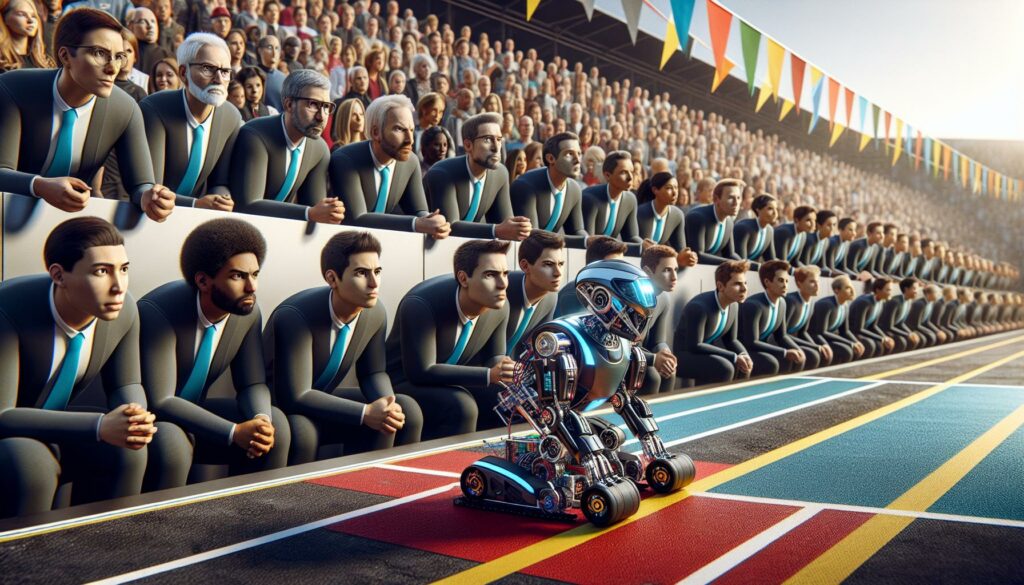In a world where technology evolves at lightning speed, robotics is taking center stage, especially in competitive arenas like the Robotics 100m. This thrilling event showcases not just the speed and agility of machines but also the innovative minds behind them. As I dive into the intricacies of this fascinating competition, I can’t help but marvel at how far we’ve come in blending engineering with creativity. The Robotics 100m isn’t just a race; it’s a testament to human ingenuity. Teams from around the globe design and build robots that push the limits of speed and precision. Join me as I explore the challenges, triumphs, and the future of robotics in this exhilarating sprint toward technological advancement. Whether you’re a tech enthusiast or just curious, there’s something here for everyone.
- Overview of Competition: The Robotics 100m is a competitive event that showcases the speed, agility, and advanced engineering of robots, demonstrating human ingenuity and innovation.
- Key Technologies: Sensing technologies (like Lidar, camera systems, and IMUs) and actuation mechanisms (such as electric and hydraulic actuators) play a crucial role in enhancing robot capabilities and performance.
- Practical Applications: Robotics 100m highlights various applications across industries, from automated manufacturing and logistics to educational platforms that inspire STEM learning.
- Challenges in Robotics: Competitors face technical limitations, including battery life, processing power, and ethical considerations regarding automation and AI accountability.
- Future Trends: Advancements in AI, autonomous navigation, energy efficiency, and materials science are shaping the future of Robotics 100m and driving innovation in the field.
- Collaboration and Ethics: The competition encourages cross-disciplinary collaboration and emphasizes the importance of ethical robotics to ensure safety and public trust in the technology.
Robotics 100m
Robotics 100m serves as a thrilling competitive event showcasing robots’ speed and agility. Teams from various countries construct robots engineered for precision and performance. The competition emphasizes innovative design and advanced programming, challenging participants to push technological boundaries.
This event includes diverse robot types, from wheeled machines to legged robots, each aiming for quick completion of a 100-meter course. Speed, maneuverability, and reliability play crucial roles in determining success. Competitors face obstacles like varied terrain, which tests their robots’ versatility and adaptation skills.
Participants often implement cutting-edge technologies, such as artificial intelligence and machine learning, to enhance their robots’ capabilities. The event not only measures performance but also demonstrates the potential of robotics in solving real-world problems.
The Robotics 100m garners attention from tech enthusiasts and industries alike, fostering collaboration and knowledge-sharing among creators. This competition highlights the importance of continuous innovation in the evolving field of robotics.
Key Technologies in Robotics 100m
The Robotics 100m relies on advanced technologies that enhance the speed, precision, and adaptability of competing robots. Key technologies play a crucial role in the performance and innovation demonstrated during the event.
Sensing Technologies
Sensing technologies enable robots to gather data about their environment, allowing for real-time decision-making. Common sensors include:
- Lidar Sensors: These sensors create high-resolution maps of the surroundings by measuring distances with laser beams. Lidar helps robots navigate obstacles effectively.
- Camera Systems: Visual data captured through cameras aids in object recognition and tracking. Image processing algorithms, combined with an AI image generator, interpret this data, enhancing navigation accuracy.
- Proximity Sensors: These sensors detect nearby obstacles, assisting in collision avoidance. Proximity sensors ensure robots maintain safe distances while moving at high speeds.
- Inertial Measurement Units (IMUs): IMUs track the robot’s orientation and movement, providing essential data for maintaining balance and stability during the race.
Actuation Mechanisms
Actuation mechanisms convert energy into motion, driving the robot’s movements. Various mechanisms contribute to the different robot types seen in the competition:
- Electric Motors: These motors provide reliable and precise movement in wheeled robots. They offer quick response times, essential for navigating dynamically during the race.
- Hydraulic Actuators: Hydraulic systems deliver high power-to-weight ratios, beneficial for legged robots. These actuators enable strong movements and provide the ability to navigate complex terrains.
- Pneumatic Actuators: Utilizing compressed air, pneumatic actuators enable lightweight movements. They allow for rapid and flexible actions vital for overcoming obstacles.
- Servo Motors: Servo motors control angular position with high accuracy, ideal for robotic arms or manipulations. Their precision capabilities enhance overall robot performance in the race.
Cutting-edge sensing and actuation technologies enhance the capabilities of competing robots, showcasing the potential of robotics in innovative applications and solutions.
Applications of Robotics 100m
Robotics 100m showcases various practical applications of robotics technology across multiple sectors. These applications highlight innovation and the potential impact of robotics on different fields.
Industrial Uses
Robotics 100m demonstrates significant industrial applications, including automated manufacturing processes, material handling, and quality control. Advanced robots increase efficiency by executing repetitive tasks, reducing human error, and enhancing production rates. For example, in assembly lines, collaborative robots, or cobots, work alongside human operators, optimizing workflows and fostering a safer working environment. Logistics also benefits from robotics, as autonomous mobile robots navigate warehouses, streamlining inventory management and order fulfillment.
Educational Insights
Robotics 100m serves as an educational platform for students and enthusiasts to explore engineering concepts and problem-solving skills. Participating teams engage in hands-on learning, applying theories from robotics, programming, and design. Educational institutions utilize events like these to inspire students, encouraging them to pursue careers in STEM fields. Workshops and seminars at competitions provide guidance on building and programming robots, fostering innovation and teamwork among participants.
Challenges Faced in Robotics 100m
Robots participating in the Robotics 100m encounter various challenges that impact their design and performance. Understanding these challenges is crucial for improving future iterations of robotic technology.
Technical Limitations
Technical limitations often hinder the performance of competing robots. Constraints in battery life can limit operational time, affecting how long robots can run before needing a recharge. Processing power is another critical factor; robots require robust CPUs and GPUs to handle complex tasks effectively. Limited communication bandwidth may impede real-time data transfer between components, affecting responsiveness. Additionally, the weight and rigidity of materials used in robot construction can restrict agility and speed. Innovations in lightweight, flexible materials and improved energy management systems are essential for overcoming these hurdles.
Ethical Considerations
Ethical considerations play a significant role in the development and deployment of robotics technology. Designers must address issues surrounding automation and the potential impact on job displacement. The use of AI in robotics raises concerns about decision-making transparency and accountability. Ensuring robots operate safely in dynamic environments also necessitates a focus on adherence to ethical guidelines. Developers should prioritize creating inclusive robots that are accessible and beneficial to all users. Balancing technological advancement with ethical responsibility is vital for fostering public trust and acceptance in robotics.
Future Trends in Robotics 100m
Future trends in Robotics 100m continue to evolve with advancements in technology and design. I observe several key areas shaping the competition’s landscape:
- Enhanced Artificial Intelligence
Artificial intelligence (AI) will play a crucial role in improving robots’ decision-making capabilities. With machine learning algorithms, robots adapt better to dynamic environments, enhancing their performance in varied terrains. - Improved Sensing Technologies
Sensing technologies advance rapidly, with Lidar, cameras, and IMUs becoming more sophisticated. These innovations provide real-time data for navigation and obstacle avoidance, ensuring robots navigate the 100-meter course efficiently. - Autonomous Navigation Systems
Autonomous navigation systems will gain prominence, allowing robots to operate with minimal human input. Systems utilizing GPS and sensor fusion enhance accuracy, helping robots maneuver through challenges seamlessly. - Energy Efficiency Innovations
Energy efficiency will become more vital as battery technology improves. Advanced energy management systems optimize power usage, extending robots’ operational time and performance during races. - Collaborative Robotics
Collaborative robotics emerges as a trend where robots work alongside humans. This synergy allows for more complex tasks and enhances safety, making robots more useful beyond competitive events. - Materials Science Developments
Innovative lightweight materials improve robots’ speed and agility. These materials reduce overall weight while maintaining strength, contributing to better performance in Robotics 100m. - Focus on Ethical Robotics
Future competitions will emphasize ethical considerations, ensuring robots are designed with user safety and job impact in mind. This focus fosters public trust and acceptance in robotics technology. - Cross-Disciplinary Collaboration
The Robotics 100m attracts collaboration across engineering disciplines. Partnerships between universities, industries, and hobbyists lead to groundbreaking research and development.
The ongoing evolution in these areas suggests a very promising future for the Robotics 100m, driving the field of robotics toward innovative solutions and applications.
The Robotics 100m is more than just a race; it’s a testament to human creativity and technological advancement. Watching teams push their limits inspires me to appreciate the incredible potential of robotics. Each event showcases not only the robots’ capabilities but also the innovative minds behind them.
As we look ahead, I’m excited about the future of robotics and the endless possibilities it holds. With advancements in AI and materials science, the next generation of robots promises to be faster and more efficient. The Robotics 100m will continue to be a platform for learning and collaboration, shaping the future of technology in ways we can only begin to imagine.

